Massage for fibromyalgia- including self help advice
Massage therapy has been shown by clinical trials to be an excellent therapy for fibromyalgia. This is because the muscular problems... Read Article
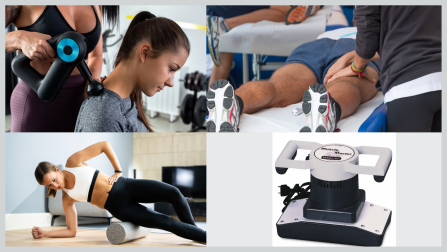
Massage therapists have long been used to help prevent sports injuries and speed recovery, but more recently foam rollers and massage guns have appeared as self help options. These provide practically unlimited therapy for little ongoing cost, but how safe and effective are they? The reality is while some forms of self massage provide excellent therapy clinical trials show that most of the heavily marketed options provide very little benefit and can potentially hurt you.
To investigate which of these therapies you should be using we will look at how effective sciences says each are for the most common sports massage uses: “warming-up” before exercise and to help you recover after.
When people think of sports massage they usually think of a professional therapist using techniques such as “rubbing”, “kneading” and “stroking”. Most therapists use a combination of these based the needs of the client. If you learn the skills it is possible to do this sort of massage on yourself, but only on parts of your body you can easily reach.
This is where vibrations are used to to penetrate and have their therapeutic effects. It is very similar to the way ultrasound works. Ultrasound is just vibrations at a higher frequency. Therapeutic vibration massage has several huge benefits.
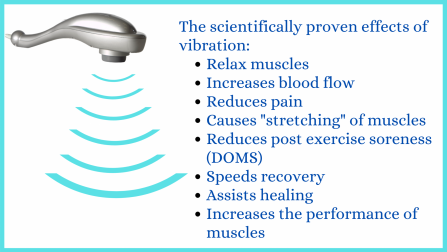
Science has found that vibrations in the therapeutic range of 30-60 Hz (cycles per second) have excellent therapeutic effects. For more information please see our article The scientifically proven effects of vibration massage- with clinical applications .
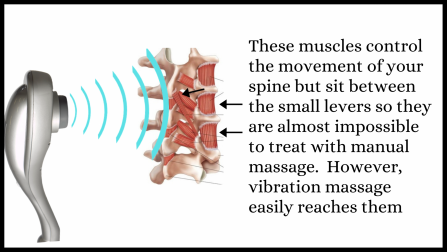
Just like ultrasound professional standard therapeutic vibrations penetrate very deeply without having to push the head into the tissues. They have no trouble reaching deep into any muscle, including spots that are difficult or impossible to access using conventional massage.
Because it is the vibrations that penetrate there is no need for the physical pressure that causes pain and can easily cause injury or damage.
There is no need to know any special massage techniques to do vibration massage. Basically all you need to do is sit the head of an appropriate vibration massager on the part to be massaged and let the vibrations penetrate. As long as you hold the machine in the right spot it will do the same job as if a professional was holding the handle.
Warning: massage guns and "consumer" massagers don't do this
As we will see genuine therapeutic vibrations provide will provide excellent benefits for both warming up and recovery. Marketers of massage guns and the flood of vibrating consumer massagers on the market will claim these benefits because their machines vibrate. The reality is that these are not powerful enough and/or use ineffective percussion (discussed later) so they do not deliver professional standard therapeutic vibrations (1). To find a genuine vibration massager please see our article How to choose a massager .
Foam rollers are devices that enable users to self apply pressure that imitates the techniques that professional therapists use. They are heavily advertised, and promote self massage. However, as we will be discussing in the scientific results below that they only give marginal or no benefits in clinical trials. This infographic shows the main reasons why.
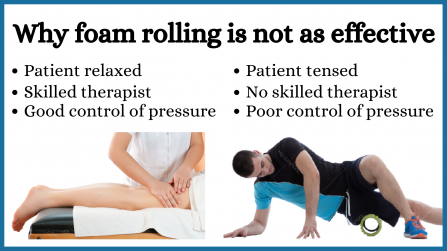
These clinical trial results represent the best possible outcome under ideal circumstances. Patients are chosen for suitability, had a professional determine the appropriate techniques, then given excellent instructions and supervision. In the real world people use them without professional instructions and supervision, often on conditions where foam rolling is inappropriate.
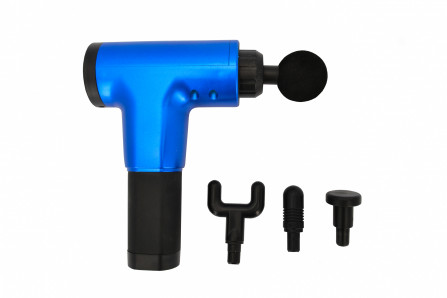
Rather than having a pad that sits on the surface and sending in vibrations massage guns are designed to drive their heads in like jackhammers. Because of this they:
Massage gun marketing can be highly deceptive and misleading, so for your protection we will highlight the key issues.
As we have seen above massage guns (percussion massagers) deliver far less vibrations than a genuine vibration massager, and they are at the wrong frequency.
It is the vibrations that penetrate and have the therapeutic effects, and a genuine vibration massager can send these right through your body. Driving the head in to increase penetration is like driving the head of an ultrasound in to increase penetration: un-necessary and dangerous.
We discuss this in our guide Are massage guns scientifically proven , but the two main issues are:
Warm-ups are done before exercise or competition, with the main goals being to help prepare muscles to prevent injuries and to enhance performance. In this section we will do is look at how well each massage option does for each of those goals. Also, stretches are often combined with massage for these, so we will look at them to.
There have been trials testing whether stretching helps prevent injuries, but to our knowledge none have been done for massage. Therefore what we can do is show you what scientists found with the stretching trials and what the experts say.
Tight muscles may tear if forced to lengthen. likewise a restricted joint may be injured if forced too far. Therefore, the goal of a warm up is to lengthen muscles to their normal operational length and to ensure all joints are able to move fully. However, trials of stretching for injury prevention have not shown a decrease in the rate of injuries (3,4). Scientist speculate that this is because stretching can have both positive and negative effects.
By lengthening the muscles they are less likely to strain or tear.
Stretching may allow joints to travel beyond their normal movement where they become more vulnerable to injury.
With this in mind it appears that the goal of any stretching and/or massage should be to to lengthen muscles to their normal operational length, but not exceed this potentially causing abnormally excessive joint movement. Keep in mind that if both massage and stretching are used their effects may be combined.
It is believed sports massage may help performance by:
Luckily there have been many trials testing this so we can definitively tell you what each massage option does. As warm-up routines often also include stretching and dynamic warm-ups (active movements) we will include info about these too.
Convention massage may help flexibility, but according to the most recent review of clinical trials there is no evidence that massage has any effect on strength, endurance or fatigue (5).
According to the results of many clinical trials the application of vibration massage of 30-60 Hz before exercise will have these positive effects on performance:
As discussed above, while massage guns vibrate they do not deliver anywhere near therapeutic vibration a proper vibration massager does, and there is no proven benefits for “jackhammering”. Further, as mentioned modifying their machines and usage negates the validity of any clinic trials. Therefore there is no scientific evidence that they have any worthwhile benefits.
Clinical trials have shown that foam rollers give no improvement in performance (10–14). The trials also show that foam rolling initially increase flexibility, but this increase only lasts less than 10 minutes (13,15,16). It seems pointless spending 10-15 minutes foam rolling only to have the increase in flexibility disappear by the time you compete.
Trials show that conventional static stretching will give a prolonged increase in flexibility, but actually decrease performance (4,17).
Dynamic warm-up means doing movement or activities. Examples include walking or exercising. This has been show to increase flexibility and strength (18). One trial found that compared with no warm-up dynamic warm-ups actually increased the height an athlete could jump by 2” (5cm) (19). The most beneficial dynamic warm-ups involve activities and movements that mirror the requirements of your sport rather general movements (19).
Science clearly shows that the two most beneficial warm-up routines are vibration massage and a dynamic warm up.
Please note that all recommendations are for general information only. For specific advice please discuss with a professional familiar with your needs.
After strenuous exercise you will likely feel feel a bit stiff and sore, and your muscles will not be capable of their normal performance. The purpose of post exercise recovery is to reduce soreness and help your muscles back to full function faster. Luckily there has been a lot of research done on this, so to give you the most helpful resource we will:
Note: the main post exercise soreness is called DOMS (Delayed Onset Muscle Soreness)
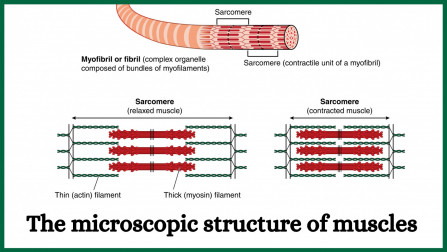
As this diagram shows your muscles are made up of microscopic fibres. Strenuous exercise will damage some of these fibres, and you will also get a build up of metabolic wastes and chemicals that result from the breakdown of damaged tissues. Also, your muscles will tighten, which presses on blood vessels, restricting the flow.
The main massage goals for recovery are to:
There have been a large number of clinical trials using conventional massage after exercise. In summary:
If you are a member or a sports club that provides massage it will feel good and you may get some benefits. However, as you will see there are better alternatives.
Vibration massage has produced by far the most benefit in clinical trials. We found nine studies where vibration massage was used after exercising. They consistently showed that this:
As well as the results of clinical trails being better and more consistent, in one trial where vibration massage and conventional massage were compared 5 minutes of vibration gave slightly better results than 15 minutes of conventional massage (36). This means that vibration gave the same (actually slightly better) results in one third of the time. If you use our professional strength four head massager this will probably be quicker still.
Despite being heavily marketed a recent review of 21 studies concluded the following (46)
"Overall it was determined that the effects of foam rolling on performance and recovery are rather minor and partially negligible."
They are not safe either. As another recent scientific journal review stated (47)
"During Foam-rolling exercises, all the underlying tissue is mechanically stressed, potentially leading to damage, for example, in neuronal tissues, receptors, vessels, or bones."
You really don’t want that for muscles that are suffering from microscopic damage and other potential injury. This is why as a Chiropractor for over 27 years I saw a lot of people hurt and injure themselves doing self massage with balls or rollers.
As discussed above, while massage guns vibrate they do not deliver anywhere near therapeutic vibration a proper vibration massager does, and there is no proven benefits for “jackhammering”. Further, as mentioned modifying their machines and usage negates the validity of any clinic trials. Therefore there is no scientific evidence that they have any worthwhile benefits.
Also, percussion massagers usually come with hard plastic heads and may drive these into your muscles up to 16 mm. It makes no sense what so ever to pummel like this to help them heal, and has previously mentioned there is a scientific journal report of a person who nearly died from injuries sustained doing so (2).
For post exercise recovery we recommend a complete strategy including adequate sleep, rest, hydration and nutrition. For more details please see our The practical, science based guide to post exercise recovery. However, there are two massages shown to help: conventional massage and vibration massage. Of these:
To use vibration massage you:
For more information please see our Guide to vibration massage .
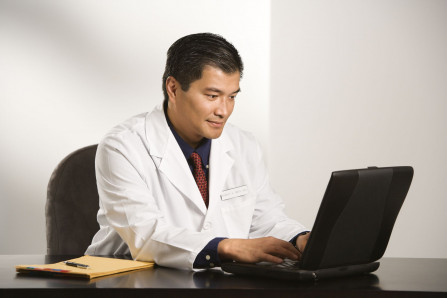
Most of our massagers sell through colleagues using our machines and recommending the therapy to patients/clients, so we are very happy to send appropriately qualiied professionals a complimentary sample machine to trial. For more info please see our Professional sample sample page .
We are continually adding more information on research and uses. Subscribe below to have us email them to you "hot off the press".

Several years ago Dr Graeme, a Chiropractor practicing in Victoria, Australia was looking for a serious hand held massager his patients could use at home to get the extra quality massage they needed. The ones he found in the shops and on-line for home use looked nice but were not serious, and... read more
Massage therapy has been shown by clinical trials to be an excellent therapy for fibromyalgia. This is because the muscular problems... Read Article
There are many possible causes of muscle fatigue, but by far the most common cause of muscle fatigue, but the most common and probably... Read Article
Cellulite is a very common problem which can be unsightly and have unpleasant symptoms. Common treatments include lasers, needles,... Read Article
Massage therapists have long been used to help prevent sports injuries and speed recovery, but more recently foam rollers and massage... Read Article
To become fitter, stronger and faster your need to push your body to create the microscopic damage that stimulates improvement. That... Read Article
If you’ve got painful trigger points your usual options are needles, laser or some form of pressure technique where you have pressure... Read Article
If you have tight hamstrings professional therapists do a great job, but can be expensive, while conventional self massage using rollers... Read Article
Most professional athletes and sports clubs make heavy use of massage type treatments. The ability to do self massage using a hand held... Read Article
Although anti-inflammatory drugs are heavily advertised and routinely prescribed for pain syndromes a recent clinical trial found them to... Read Article
As a Chiropractor for over 27 years a lot of information I’ve seen about chiropractic adjustments has been misleading or just plain... Read Article
There are a variety of systems of “pressure points” used for health benefits and to relieve pain. They all have their devoted advocates... Read Article
Do not refresh or leave this page until loading complete.